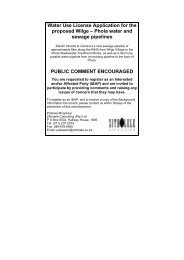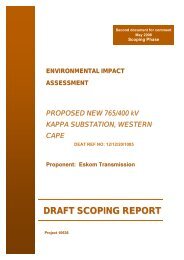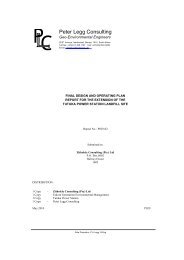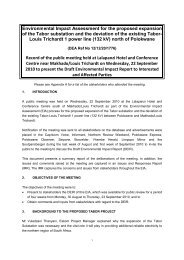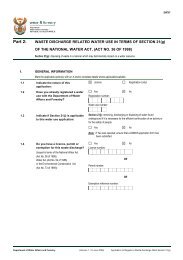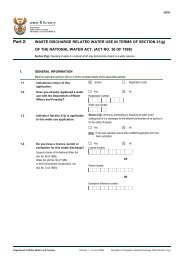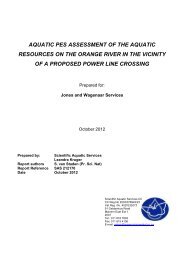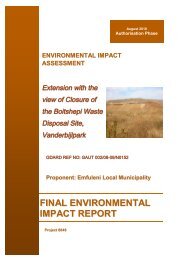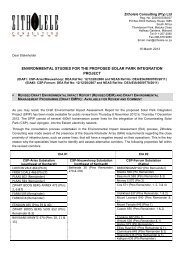Draft Basic Assessment Report.pdf - Zitholele.co.za
Draft Basic Assessment Report.pdf - Zitholele.co.za
Draft Basic Assessment Report.pdf - Zitholele.co.za
You also want an ePaper? Increase the reach of your titles
YUMPU automatically turns print PDFs into web optimized ePapers that Google loves.
BASIC ASSESSMENT REPORT<br />
SECTION D: IMPACT ASSESSMENT<br />
The assessment of impacts must adhere to the minimum requirements in the EIA Regulations, 2010,<br />
and should take applicable official guidelines into ac<strong>co</strong>unt. The issues raised by interested and<br />
affected parties should also be addressed in the assessment of impacts.<br />
1. ISSUES RAISED BY INTERESTED AND AFFECTED PARTIES<br />
List the main issues raised by interested and affected parties.<br />
1. Air quality<br />
2. Job creation<br />
Response from the practitioner to the issues raised by the interested and affected parties (A full<br />
response must be given in the Comments and Response <strong>Report</strong> that must be attached to this report as<br />
Annexure E):<br />
1. Air quality – the proposed development will reduce the existing emissions from<br />
Duvha Unit 4 a limit of 75 mg/Nm 3 to a limit of 50 mg/Nm 3<br />
2. Job creation – as indicated in the socio e<strong>co</strong>nomic section 30 jobs will be created<br />
during the <strong>co</strong>nstruction phase of this project, where 90% will be for the HDIs,<br />
and the 10% will be for skilled personnel. During operation, temporary (5 week<br />
duration) jobs will be created every 4 years during the replacement of the filter<br />
bags. It is anticipated that local labour will be sourced.<br />
2. IMPACTS THAT MAY RESULT FROM THE PLANNING AND DESIGN, CONSTRUCTION,<br />
OPERATIONAL, DECOMMISSIONING AND CLOSURE PHASES AS WELL AS PROPOSED<br />
MANAGEMENT OF IDENTIFIED IMPACTS AND PROPOSED MITIGATION MEASURES<br />
List the potential direct, indirect and cumulative property/activity/design/technology/operational<br />
alternative related impacts (as appropriate) that are likely to occur as a result of the planning and<br />
design phase, <strong>co</strong>nstruction phase, operational phase, de<strong>co</strong>mmissioning and closure phase, including<br />
impacts relating to the choice of site/activity/technology alternatives as well as the mitigation measures<br />
that may eliminate or reduce the potential impacts listed.<br />
To ensure uniformity, the assessment of impacts is addressed in a standard manner so that a wide range of impacts can be <strong>co</strong>mpared<br />
with each other. For this reason a clearly defined significance rating scale is provided to assess the significance (importance) of the<br />
associated impacts. The scale embraces the notion of extent and magnitude, but does not always clearly define these since their<br />
importance in the rating scale is very relative. For example, the magnitude (i.e. the size) of area affected by atmospheric pollution may<br />
be extremely large (1000 km²) but the significance of this effect is dependent on the <strong>co</strong>ncentration or level of pollution. If the<br />
<strong>co</strong>ncentration were great, the significance of the impact would be HIGH or VERY HIGH, but if it were dilute it would be LOW or VERY<br />
LOW. Similarly, if 60 ha of a grassland type are destroyed the impact would be VERY HIGH if only 100 ha of that grassland type was<br />
known. The impact would be VERY LOW if the grassland type were <strong>co</strong>mmon.<br />
The potential significance of every environmental impact identified is determined by using a ranking scale, based on the following (the<br />
terminology is extracted from the DEA guideline document on EIA Regulations, April 1998):<br />
Occurrence<br />
• Probability of occurrence (how likely is it that the impact may occur), and<br />
• Duration of occurrence (how long may it last)



